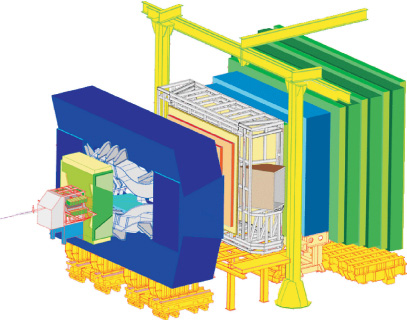Hi My Friends: A VUELO DE UN QUINDE EL BLOG., The Large Hadron Collider (LHC) is a gigantic scientific instrument near
Geneva, where it spans the border between Switzerland and France about
100m underground. It is a particle accelerator
used by physicists to study the smallest known particles – the
fundamental building blocks of all things. It will revolutionise our
understanding, from the minuscule world deep within atoms to the
vastness of the Universe.
CERN-EX-0404009 01 Small Medium Large
LHCb experiment magnets
Aimants de l'expérience LHCb
Aimants de l'expérience LHCb
The leading members of the LHCb magnet project, from left to right:
Pierre-Ange Giudici, who organized and supervised the industrial
production of the coils; Marcello Losasso, who performed the 3D
calculations to optimise the magnetic field; Olivier Jamet, responsible
for the 3D design; Jean Renaud, in charge of the magnet assembly, and
Wilfried Flegel, project leader. The LHCb detector will investigate
matter-antimatter differences in B mesons at the LHC. The coils of the
detector's huge dipole magnet are seen here in April 2004.
Les créateurs, devant leur «créature» ! De gauche à droite, les principaux participants au projet de l'aimant de LHCb : Pierre-Ange Giudici pour l'organisation et le suivi de fabrication des bobines, Marcello Losasso pour les calculs 3D optimisant le champ magnétique, Olivier Jamet pour les dessins 3D, Jean Renaud, responsable de l'assemblage de l'aimant, Wilfried Flegel, chef du projet.
Les créateurs, devant leur «créature» ! De gauche à droite, les principaux participants au projet de l'aimant de LHCb : Pierre-Ange Giudici pour l'organisation et le suivi de fabrication des bobines, Marcello Losasso pour les calculs 3D optimisant le champ magnétique, Olivier Jamet pour les dessins 3D, Jean Renaud, responsable de l'assemblage de l'aimant, Wilfried Flegel, chef du projet.
Photograph: Maximilien Brice
Date: 15 Apr 2004
Keywords: CERN50; LHCb; LHC; magnet; group; bobine; detecteur; detector
Access: DIGITAL
Related links:
CERN Bulletin 18/2004
CERN Courier vol 44 no 8 : October 2004
Available tirages: 01 02 03 04
LHCb
Large Hadron Collider beauty
The LHCb experiment will help us to understand why we live in a Universe that appears to be composed almost entirely of matter, but no antimatter.It specialises in investigating the slight differences between matter and antimatter by studying a type of particle called the 'beauty quark', or 'b quark'.
Instead of surrounding the entire collision point with an enclosed detector, the LHCb experiment uses a series of sub-detectors to detect mainly forward particles. The first sub-detector is mounted close to the collision point, while the next ones stand one behind the other, over a length of 20 m.
An abundance of different types of quark will be created by the LHC before they decay quickly into other forms. To catch the b-quarks, LHCb has developed sophisticated movable tracking detectors close to the path of the beams circling in the LHC.
The LHCb collaboration has 650 scientists from 48 institutes in 13 countries (April 2006).

LHCb detector
- Size: 21m long, 10m high and 13m wide
- Weight: 5600 tonnes
- Design: forward spectrometer with planar detectors
- Location: Ferney-Voltaire, France.
Guillermo Gonzalo Sánchez Achutegui
ayabaca@gmail.com
ayabaca@hotmail.com
ayabaca@yahoo.com
Inscríbete en el Foro del blog y participa : A Vuelo De Un Quinde - El Foro!


No hay comentarios:
Publicar un comentario